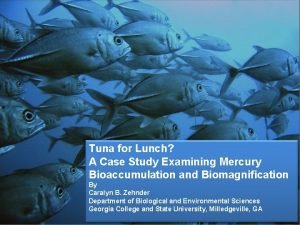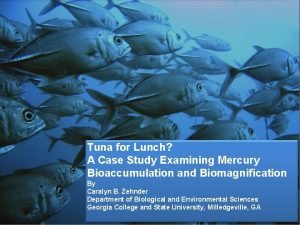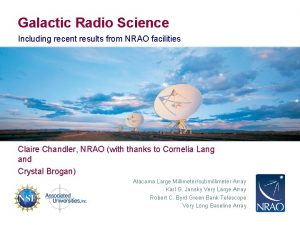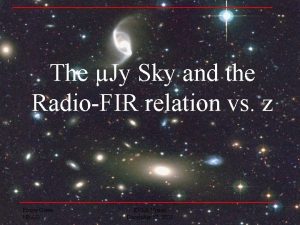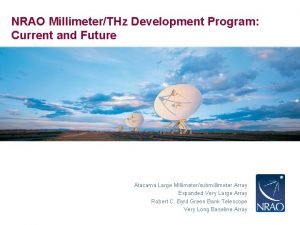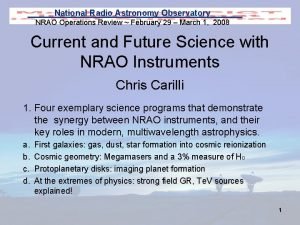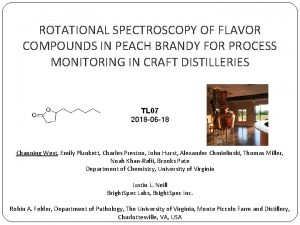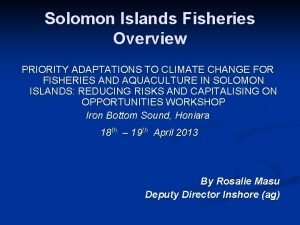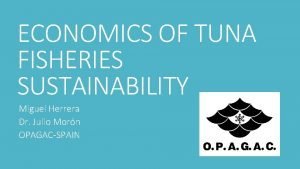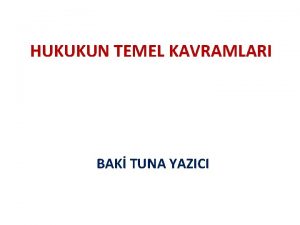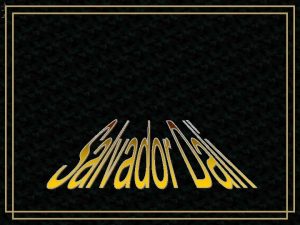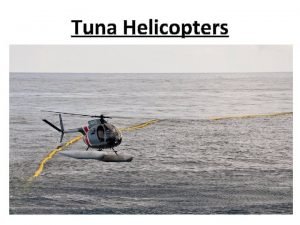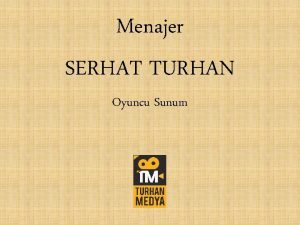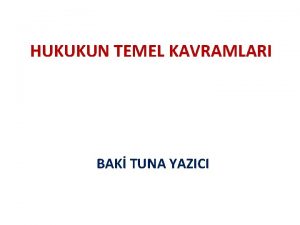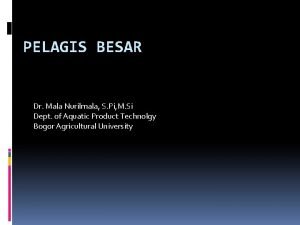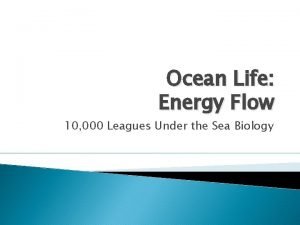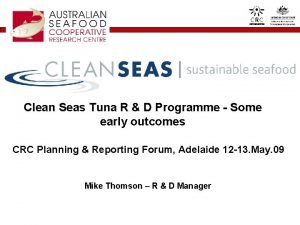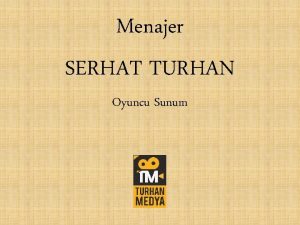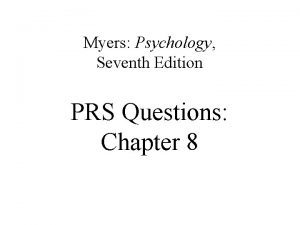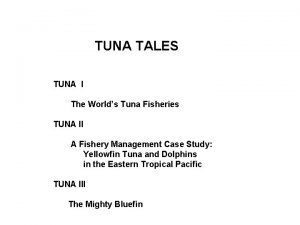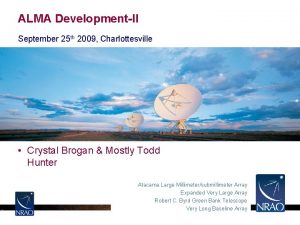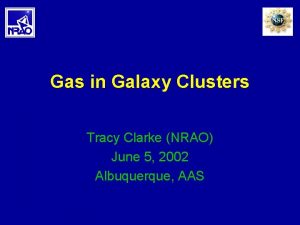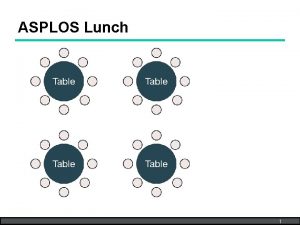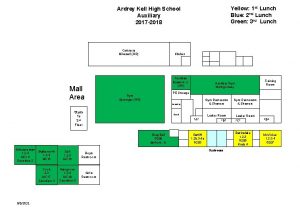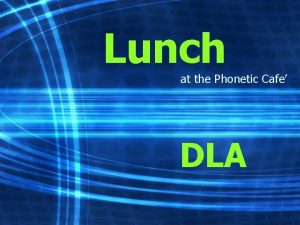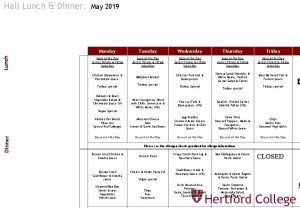Tuna Lunch June 2 2009 Charlottesville Va NRAO


































- Slides: 34

Tuna Lunch June 2, 2009 – Charlottesville, Va. NRAO and the AS 2010 Overview of the ALMA submission to the DS 2010 Instrumentation Panel. A. Wootten (Project Scientist/NA) Atacama Large Millimeter/submillimeter Array Expanded Very Large Array Robert C. Byrd Green Bank Telescope Very Long Baseline Array

ALMA Phases ALMA • Construction now declining, Operations continuing rampup. • Continued Development was featured in the Ops Plan, reviewed by Intl Committee and by NSF Committee then adopted by Board. • No funding agency funds a ‘pig in a poke’, the character of development must be defined. This is up to the ALMA Board, now pondering. Tuna Lunch

ALMA Science Requirements Project scientist ensures ALMA meets three “level I” science goals: • Spectral line CO/C+ in z=3 MWG < 24 hrs • resolve Proto. Planetary. Disks at 150 pc – gas/dust/fields • Precise 0. 1” imaging above 0. 1% peak • • High Fidelity Imaging. Routine sub-m. Jy Continuum / m. K Spectral Sensitivity. Wideband Frequency Coverage. Wide Field Imaging Mosaicing. Submillimeter Receiver System (. . & site. . ). Full Polarization Capability. System Flexibility (hardware/software). Tuna Lunch

Technical Specifications • • • • • ALMA 50 12 -m antennas, 12 7 -m antennas, 4 TP 12 m antennas at 5000 m altitude site. – 14 antennas ‘descoped’ during rebaselining. Only ~47 operational at a given time! Surface accuracy ± 25 m, 0. 6” reference pointing in 9 m/s wind, 2” absolute pointing all-sky. First three antennas meet these; accurate to <± 16 m most conditions Array configurations between 150 m to ~15 -18 km. 10 bands in 31 -950 GHz + 183 GHz WVR. Only 7 included in construction phase. 84 -116 GHz “ 3” 125 -169 GHz “ 4” 163 -211 GHz “ 5” 6 rx only, dual polzn 211 -275 GHz “ 6” 275 -373 GHz “ 7” 385 -500 GHz “ 8” 602 -720 GHz “ 9” 787 -950 GHz “ 10” initially partially populated 8 GHz BW, dual polarization. Flux sensitivity 0. 2 m. Jy in 1 min at 345 GHz (median cond. ). Interferometry, mosaicing & total-power observing but no VLB capability Correlator: 4096 channels/IF (multi-IF), full Stokes. Data rate: 6 MB/s average; peak 60 MB/s. Tuna Lunch All data archived (raw + images), pipeline processing.

ALMA Bands and Transparency 7 Bands in Construction Project— 3 ‘descoped’ B 2 B 4 B 6 B 7 B 8 B 1 B 3 B 5 B 9 B 10 ‘B 11’ Tuna Lunch 0. 5 mm PWV ν<950 GHz 0. 2 mm PWV ν>950 GHz

ALMA Specifications Breed Transformational Performance • With these specifications, ALMA improves • • • Existing sensitivity, by about two orders of magnitude • Best accessible site on Earth • Highest performance receivers available • Enormous collecting area (1. 6 acres, or >6600 m 2) Resolution, by nearly two orders of magnitude • Not only is the site high and dry but it is big! 18 km baselines or longer may be accommodated. Wavelength Coverage, by a factor of two or more • Take advantage of the site by covering all atmospheric windows with >50% transmission above 30 GHz Bandwidth, by a factor of a few • Correlator processes 16 GHz or 8 GHz times two polarizations Scientific discovery parameter space is greatly expanded! Tuna Lunch

ALMA Development Items for ALMA 2010 -2020 • Science clearly benefits from improving – Throughput (collecting area, instantaneous bandwidth, uv coverage) – Bandwidth (all accessible frequencies) – Resolution • Proposal: First implement unfunded construction scope – Unbuilt antennas (while production line remains open) – Unbuilt receivers (and consider bands not contemplated prior) – Unimplemented VLB capability • Many other possibilities – ASAC Report – Correlator upgrade – Longer connected baselines – Are any science goals endangered to whose realization development could contribute? Tuna Lunch

ASAC Recommendations ALMA Tuna Lunch

Science Goal I: Detect CO or C+ in MWG • At z=2 this can be done for both lines • At z=3 this becomes difficult for the CO line • But notice the ‘tall pole’ atomic lines in the THz region, including C+ C+ CO J=3 -2 GBT ALMA Combes

Science Goal I: Detect CO or C+ in MWG Viable; depends on exact redshift and transparency window lineup. For MW galaxy, detection takes a few hours. Note that other lines on the plot, from luminous galaxies in the local Universe, may be detected, some at very high z. ALMA allows us to see the redshifted ‘tall pole’ THz lines to very high z. ALMA could track the very creation of the Universe’s ‘metals’. ALMA Maiolino and Testi

Birth of Stars and Planets ALMA Evolutionary Sequence— Molecular Cloud Core to Protostar (104 yrs) to Protoplanetary Disk (to ~106 yrs) to Debris Disk (to 109 yrs) GBT/Mustang Synergy Wolf and D’Angelo 2005 Lodato and Rice 2005 M. Wyatt; R. Reid 25 AU 160 AU 5 AU Vega Dust Disk

Highest Level Science Goals ALMA Bilateral Agreement Annex B: “ALMA’s third level-1 science requirement: The ability to provide precise images at an angular resolution of 0. 1". Here the term precise image means accurately representing the sky brightness at all points where the brightness is greater than 0. 1% of the peak image brightness. This requirement applies to all sources visible to ALMA that transit at an elevation greater than 20 degrees. These requirements drive the technical specifications of ALMA. “

Imaging Ability ALMA • 2005 NRC Panel: – “Two of the Level-1 science goals, involving sensitivity and high-contrast imaging of protostellar disks, will not be met with either a 40 - or a 50 -antenna array. It is not clear if the third requirement, on dynamic range, can be met with a 40 antenna array even if extremely long integrations are allowed for. – “Speed, image fidelity, mosaicing ability, 2 and point-source sensitivity will all be affected if the ALMA array is descoped. The severest degradation is in image fidelity, which will be reduced by factors of 2 and 3 with descopes to 50 and 40 antennas, respectively. – “Despite not achieving the level-1 requirements, a descoped array with 50 or 40 antennas would still be capable of producing transformational results, particularly in advancing understanding of the youngest galaxies in the universe, how the majority of galaxies evolved, and the structure of protoplanetary disks, and would warrant continued support by the United States. ” • Holdaway memo ‘Image Quality as a Function of the Number of Antennas in ALMA’ Tuna Lunch

How many Antennas? • • • ALMA NRC Committee: At least 54, 50 operating. Holdaway: We perform simulations of ALMA data for array configurations with the number of antennas (Na) ranging from 40, 43, 46, 50, and 56, adding only thermal noise. For very high SNR observations (ie, 10000: 1), the dynamic range shows a strong dependence upon N a, with 56 antennas yielding far superior images to 40 antennas. For high SNR (ie, 3000: 1), the dynamic range shows only a modest dependence on N a, and at 1000: 1 SNR and below, all arrays are basically able to achieve theoretical dynamic range. However, even though all configurations seem to be able to achieve thermal noise limited imaging from the perspective of dynamic range, configurations with fewer antennas provide image reconstructions with on-source errors which are far from theoretical maximum. For these simulations, the 56 element configuration produces images which have nearly thermal noise limited fidelity up to the very highest SNR, where at last deconvolution errors begin to limit the image quality instead of thermal noise. Conclusion: 4 -7 additional antennas could enable meeting goals 2 and 3. Tuna Lunch

ALMA Summary of Enhanced ALMA 2020+ Tuna Lunch

31 -45 GHz Astronomy ALMA • Redshifted CO lines • Sunyaev-Zeldovich Effect • Excellent probe of very dense dust disks • debris disks • chemistry of heavy organic species, carbon-chains, anions • free-free emission from jets/outflows • measuring B-field using Zeeman effect (CCS) • spinning dust grains • dust chemistry in AGB envelopes • masers Tuna Lunch

67 -94 GHz Astronomy ALMA • 67 -94 GHz: Resonance lines of abundant molecules – HCO+, HCN, HNC, N 2 H+, H 2 CO • Resonance lines of their deuterium isotopomers – DCO+, DCN, DNC, N 2 D+, NH 2 D, NHD 2, HDO, CH 2 D+ • Underutilized band but rx technology straightforward • Excellent probe of very dense dust disks • Comets--PD zone often resolved, no missing Tuna Lunch flux.

Extragalactic Targets ALMA • Redshifted CO (including Milky Way at z~3) • LIRGs 0. 2<z<0. 7 – LIR~5 LIR(MW) L(CO)1 -0~5 L(CO)1 -0, MW – Tsys~250 K SSB; Jy/K~0. 8 – 1 8 hrs 1 m. K 75 km/s (10 K km/s) – Could probably measure CO in ~two dozen MIPS-detected LIRGS in HDF falling in this redshift range – ‘Age’ 7. 4 -11. 3 Gyr; Scale 24 -50 kpc/beam • Sunyaev-Zeldovich Effect Tuna Lunch

Examples ALMA • MIPS 4644, z=0. 67 • Note ALMA synthesized beam Tuna Lunch

Examples ALMA • MIPS 15942, z=0. 44 Tuna Lunch

ALMA Inverse K-correction, or magic of the submillimeter §As galaxies get redshifted into the ALMA bands, dimming due to distance is offset by the brighter part of the spectrum being redshifted in. Hence, galaxies remain at relatively similar brightness out to high distances. But first stars formed z~10…spectra differed. Super M 82 from ISO, Beelen and Cox 10 11

Band 5 (163 -211 GHz) • Water! High resolution Herschel followup • Redshifted CO and z~10 C+ ALMA

How can I find the ALMA Site? ALMA Paranal La Serena Santiago Tuna Lunch

Eleven Years of Data ALMA APEX July 2008 PWV < 200 μm for ~10% of time Can be better in winter Chajnantor: An Excellent Site for THz Astronomy Data courtesy S. Radford Tuna Lunch

APEX ALMA • APEX is a slightly modified copy of the ALMA prototype built by Vertex. • It has operated on the ALMA site since 2005. • The surface is ~17 μm and has remained stable. • Observations have been published which were made in the 1. 4 • ALMA has an excellent and proven site for THz astronomy THz atmospheric • ALMA has two prototype antennas; a copy of one is doing window. THz astronomy • Bids now being considered for prototypes! • What are ALMA’s science goals and how do they drive development? Tuna Lunch

ALMA ‘Band 11’: Creation of the Metals When chemistry got interesting (H 3+, H 2 D+, H 2, HD notwithstanding) ALMA should be able to monitor the creation of • O ([O I], [O III], OH, H 2 O) • C ([C I], [C II], CO, CH+, 13 C) • N ([N II], NH, N 2 H+)

ALMA Opening Up the Dark Side of Reionization After R. Barkana Tuna Lunch

ALMA into the Eo. R ALMA Spectral simulation of J 1148+5251 CO HCO+ HCN CCH §Detect dust emission in 1 sec (5 ) at 250 GHz § Detect multiple lines, molecules per band => detailed astrochemistry § Image dust and gas at sub-kpc resolution – gas dynamics! CO map at 0”. 15 resolution in 1. 5 hours [C II]: 60 sec (10σ) at 256 GHz [O I] 63 µm at 641 GHz [O I] 145 µm at 277 GHz [O III] 88 µm at 457 GHz [N II] 122 µm at 332 GHz [N II] 205 µm at 197 GHz HD 112 µm at 361 GHz

J 1148: A possible (not from Chajnantor!) H 2 observation An early (z=6. 42; 0. 8 Gyr) massive and exteded region of tremendous star formation ~1000 Msun/yr/kpc 2 Region ~750 pc radius Similar to Arp 220 but 100 times larger Mass ~2 1010 Msun ALMA

Dark Side of Reionization ALMA 1 hr, 5σ, 300 km/s Single to score of clouds of 108 Msun B 11 ALMA B 10 After Appleton et al 2009

VLB Capability ALMA • ALMA as a very sensitive node in a breakthrough array could enable: – Imaging of the Black Hole at the center of our Galaxy – Few 10 microarcsec resolution – Include with sensitive elements elsewhere: • GBT 3 mm and below • LMT to 345 GHz • CARMA, SMA, JCMT, CSO • Element of SA Array (~1 milliarcsec resolution) – ALMA Prototypes on high Argentine peaks (Brazil-Argentina proposal) • Several tens milliarcsec astrometry characterizes exosolar planets • Stellar photospheres resolved with beams much below 1 milliarcsec • Measure motions of galactic masers • High resolution observations of extragalactic megamasers (compare with VLBA project) – Resited SMA (Sairecabur? ) – CCAT (short baseline) Tuna Lunch

Push to Early Science ALMA • Interferometry at 2900 m June 2009 and onwards – Move past accomplishments at the ATF – Production equipment, for the most part – Still one baseline • Antennas exiting AIV phases moved to 5000 m Aug/Sep 2009 • Interferometry at 5000 m Nov/Dec 2009 – Beginning of Commissioning and Science Verification – First use of LO, correlators, B 8, B 9 and eventually B 10 • Call for Early Science Proposals Dec 2010 • Early Science Q 4 FY 2011 Tuna Lunch

ALMA’s First Ten Years ALMA • A feature of ALMA Operations is Development • Possibilities: – Finishing unfinished frequency bands – Expand collecting area to recommended 64 x 12 m telescopes – Expand resolution by adding VLB capability – Addition of new bands—more challenging, but a ‘Band 11’ seems unusually promising given the thrust of science, the excellence of the site and the promise of the first antennas • Synergies with GBT – Together, they cover the whole sky – ALMA’s Field of View is limited—finding the interesting objects might best be done by arrays on large telescopes—GBT, LMT, CCAT – Two unbuilt ALMA bands overlap GBT coverage—prototyping e. g. 67 -90 GHz B 2 ALMA receiver

ALMA is nearly here! ALMA D. Barkats The Atacama Large Millimeter/submillimeter Array (ALMA), an international astronomy facility, is a partnership of Europe, North America and Eas cooperation with the Republic of Chile. ALMA is funded in Europe by the European Organization for Astronomical Research in the Southern Hemisphere (ESO), in North America by the U. S. National Science Foundation (NSF) in cooperation with the National Research Council of Canada (NRC) and the National Science Council of Taiwan (NSC) and in East Asia by the National Institutes of Natural Sciences (NINS) of Japan in cooperation with the Academia Sinica (AS) in Taiwan. ALMA construction and operations are led on behalf of Europe by ESO, on behalf of North America by the National Radio Astronomy Observatory (NRAO), which is managed by Associated Universities, Inc. (AUI) and on behalf of East Asia by the National Astronomical Observatory of Japan (NAOJ). The Joint ALMA Observatory (JAO) provides the unified leadership and management of the construction, commissioning and operation of ALMA. Tuna Lunch
 Tuna for lunch case study
Tuna for lunch case study Tuna for lunch case study
Tuna for lunch case study Nrao
Nrao Nrao
Nrao Mynrao
Mynrao Nrao
Nrao Nrao
Nrao Nws probabilistic snow forecast
Nws probabilistic snow forecast Fids charlottesville
Fids charlottesville Vdoe writing rubric
Vdoe writing rubric Hukukun asli kaynakları
Hukukun asli kaynakları Tuna food web
Tuna food web Pna tuna
Pna tuna Baki tuna yazıcı
Baki tuna yazıcı Dr miguel tuna
Dr miguel tuna Gilles hosch
Gilles hosch Baki tuna yazıcı
Baki tuna yazıcı Keuntungan bahan setengah jadi
Keuntungan bahan setengah jadi Baki tuna yazıcı
Baki tuna yazıcı Invisible sleeping woman horse lion
Invisible sleeping woman horse lion Ullvi tuna vårdcentral
Ullvi tuna vårdcentral Tuna boat helicopter
Tuna boat helicopter Baki tuna yazıcı
Baki tuna yazıcı Akasya durağı stelyo gerçek adı
Akasya durağı stelyo gerçek adı Tuna yazıcı
Tuna yazıcı Tuna food web
Tuna food web Nama latin ikan tuna sirip biru
Nama latin ikan tuna sirip biru Tuna food web
Tuna food web Clean seas tuna
Clean seas tuna Serhat turhan kimdir
Serhat turhan kimdir Ayrampo tuna
Ayrampo tuna Brian ate a tuna salad sandwich
Brian ate a tuna salad sandwich Inferring phylogenies using derived characters
Inferring phylogenies using derived characters Summary period: june 2021 poem
Summary period: june 2021 poem June's journey
June's journey
